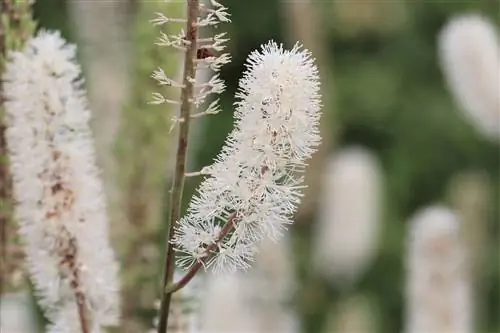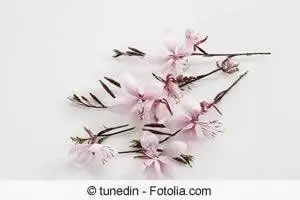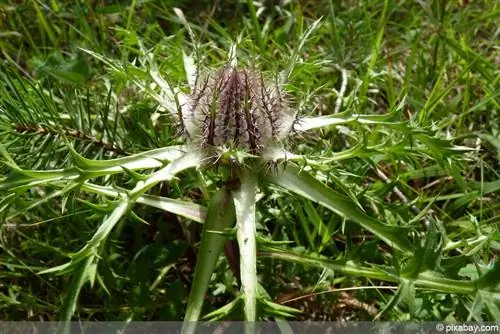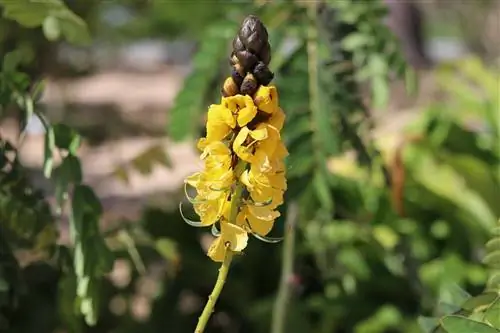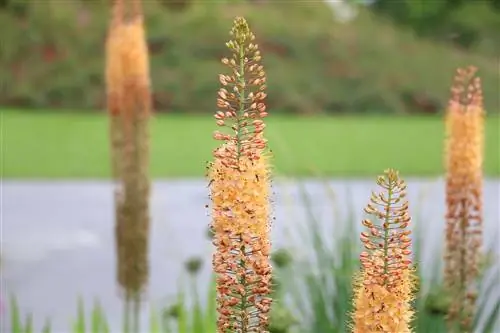- Author admin [email protected].
- Public 2023-12-17 03:39.
- Last modified 2025-01-24 12:45.
The silver cohosh, also known as lady's root or bedbug weed, is a shade plant and therefore the perfect neighbor for trees or bushes in the garden. Since it blooms late, the autumn-winter garden is enhanced by the distinctive white flower spikes. The plant is also often used for beautiful autumn bouquets. The robust, perennial and hardy perennial is very easy to care for and is therefore the ideal plant for every gardening beginner to bring a little color into the garden in autumn.
Location
The silver candle prefers a shady location and is therefore a suitable neighbor for shrubs and trees near which not many flowers thrive due to the amount of shade. However, it doesn't feel particularly comfortable in direct sun. If the silver candle is cultivated in a bucket, it is particularly suitable for north-facing balconies or covered terraces.
Tip:
It can look very empty, especially under trees in the garden. A few silver candles planted around the area bring more focal points into the garden.
Substrate & Soil
The silver candle always needs enough moisture to thrive. If it looks stunted, this could be an indication that the soil is too dry. However, avoid waterlogging at all costs. The substrate should have the following properties:
- nutrient-rich
- cool and slightly damp due to shade
- Avoid and remove weed growth around the plant
Tip:
With this type of care, the silver candle can live ten to even twenty years in its chosen location.
Watering & Fertilizing
The silver candle is also extremely easy to care for when fertilizing and watering. The procedure is as follows:
- use leaf mold or compost for fertilization
- fertilizing once a year is sufficient
- mix in the natural fertilizer in March
- always keep the soil slightly moist
- of course this works best in the shade
- Avoid waterlogging
- only water in extremely dry periods when the soil on the surface has dried out
- naturally falling rain is otherwise completely sufficient for the silver candle
Cutting
The silver candle is a plant from the perennial genus. Therefore, the silver candle should be cut to the ground before winter after flowering. So it will sprout again next spring. However, this radical pruning should only be done from the third year of planting to give the perennial time to get used to its new environment. For the rest of the year, only faded and dried parts are removed.
Tip:
If the silver candle is left alone for the first two or three years and not cut back, it will reward you with particularly beautiful and lush growth.
Propagate
The silver cohosh, like most types of perennials, can be easily propagated by division. The ideal time for this is spring before the flowers emerge or immediately after flowering in early winter. Perennials in particular need to be divided every now and then so that they don't get too big and grow profusely. They are rejuvenated by division and then become more vigorous and vital again. In addition, division is a good way to propagate these easy-care perennials. You should proceed as follows:
- Carefully dig up the silver candle plant with a spade
- prick around the plant
- divide the dug up perennial by hand or, in the case of a hard root ball, with a spade
- this can be done in several small pieces or just two larger pieces of perennials
- remove dried leaves, stems or flowers
- shorten individual pieces by a third in the upper area and at the root with scissors
- use disinfected scissors to ensure that no bacteria or fungi are transmitted
- and the divided perennials are not damaged by diseases
- ideally replant all silver candles received immediately after dividing
Plants
If the right location has been chosen for the silver candle, it is planted here as follows:
- make sure that the perennial has enough space at the top, for example under a hedge
- over the years it also spreads through self-propagation
- prepare a sufficiently large hole
- mix the excavated soil with compost or leaf mold
- use a wheelbarrow for this
- Insert the perennial and add the soil around it
- press lightly and water moderately
- the ideal planting time is spring
- A flowering perennial from the market can also be planted in summer or early autumn
- For cultivation in the bucket, make sure that it offers the roots enough space on all sides
- Use garden soil or potting soil for potted plants
- no fertilizer needs to be added when planting in the first year
- Create drainage in the bucket to prevent waterlogging
- Spread stones, pebbles or shards of pottery over the drain hole and cover with plant fleece
- then the earth will be filled
- Insert the perennial, fill in the remaining soil, press lightly and water moderately
Repotting
If the silver candle was grown in a bucket, it needs to be repotted or divided every few years. Because it reproduces on its own, after two to three years the pot chosen usually becomes too small for the plant. If the same pot is to be used again, the perennial is divided. The new plants are then placed in their own pots or directly in the garden bed. Otherwise, proceed as follows when repotting:
- Carefully pull the perennial out of the moist soil
- prepare the new pot with drainage
- Enter a part of soil, insert silver candle and distribute the rest of soil
- water lightly
- A divided perennial can be reinserted into its old pot with the remaining soil
- Silver candles do not need to be moved to a new location and fresh soil to thrive better
Tip:
If the hobby gardener has no use for the cut pieces of perennials, he can also give them away to his garden neighbors.
Wintering
The silver candle is hardy and does not require any preparation for an upcoming winter.
Care errors, diseases or pests
The silver candle is not susceptible to pests, but if it appears stunted, this can be remedied by moving to a shady place with moist soil.
Conclusion of the editors
If you are looking for an autumn-flowering plant for your garden that is also easy to care for, hardy and undemanding and prefers a shady location, the silver candle is a good choice. Because it requires little care and is ideal in shady, bright corners, under trees or near hedges. This means that otherwise forgotten corners in the garden can become dreamy places until early winter.
What you should know about the silver candle in brief
- Species/Family: Perennial; belongs to the buttercup family (Ranunculaceae)
- Flowering time: depending on the species and variety from July to October in creamy white or white
- Foliage: three-part pinnate leaves, depending on the species and variety, green, green-black or red-brown, often with yellow autumn color
- Growth: forms dense clumps of leaves from which strongly branched, upright flower stalks protrude
- Height: 100 to 200 cm
- Location: partially shaded; cool and protected from the wind, prefers to be at the edge of the pond in light shade; moist, humus-rich, nutrient-rich soil; Some species also tolerate sunny or shady locations
- Planting time: any time as long as the ground is not frozen
- Pruning: pruning close to the ground in spring before new growth
- Partner: works well in front of conifers, good as a solitary perennial; However, it also goes well with monkshood, Japanese anemones, tall bellflowers, ferns, shade grasses
- Propagation: Division in early spring; can also be sown after flowering, although seeds germinate poorly
- Care: Soil should not dry out completely; If leaves are left lying around, they are processed into humus; then no fertilizer necessary
- Overwintering: is grateful for winter protection after pruning in autumn; Pruning is done in spring. Protection is not necessary
- Special features: Flowers are very popular with insects
Types of silver candles
- July silver cohosh - Black cohosh (Cimicifuga racemosa): Blooms in summer with upright flower candles consisting of many small, radiating white-yellow flowers that bloom from below
- Lance Silver Cohosh (Cimicifuga racemosa var. Cordifolia): Blooms from August to October. Also tolerates sunny locations
- October silver candle (Cimicifuga simplex): blooms from October to November with long, pipe cleaner-like, arching flower panicles consisting of densely seated small white flowers, some varieties fragrant; adapts to any floor; should have a place where it can shine in the fall
- Purple Silver Candle: Blooms in pure white; is particularly noticeable due to its dark brown-red leaves
- September silver candle (Cimicifuga ramosa): height up to 200 cm; blooms from September to October with long, thin, slightly curved flower candles with many small individual flowers in white, pleasantly fragrant; also tolerates shady locations; is native to the Asian Kamchatka Peninsula; has the charm of a wild perennial
Varieties (selection)
- `Candelabrum: October silver candle. height 140cm; stands out due to its strong branching and pure white flowers
- `Brunette: September silver candle. height 150cm; blooms from September to October with long, loosely decorated, fragrant flower candles in silvery-white; striking green-black leaves
- `Hänse Herms: October silver candle. height 100cm; very compact growing with white flowers
Usage
Extracts that have an estrogen-like effect are obtained from the rhizome of the July silver candle. Medications with these extracts help with menopausal symptoms, especially against hot flashes, and they are also suitable as a herbal alternative to hormone therapy

